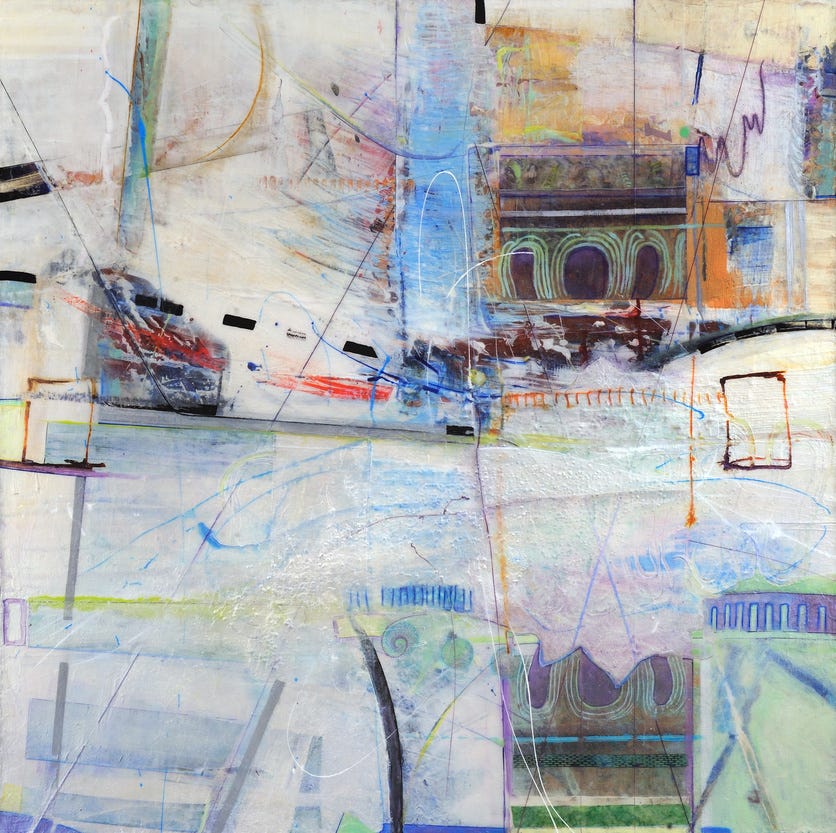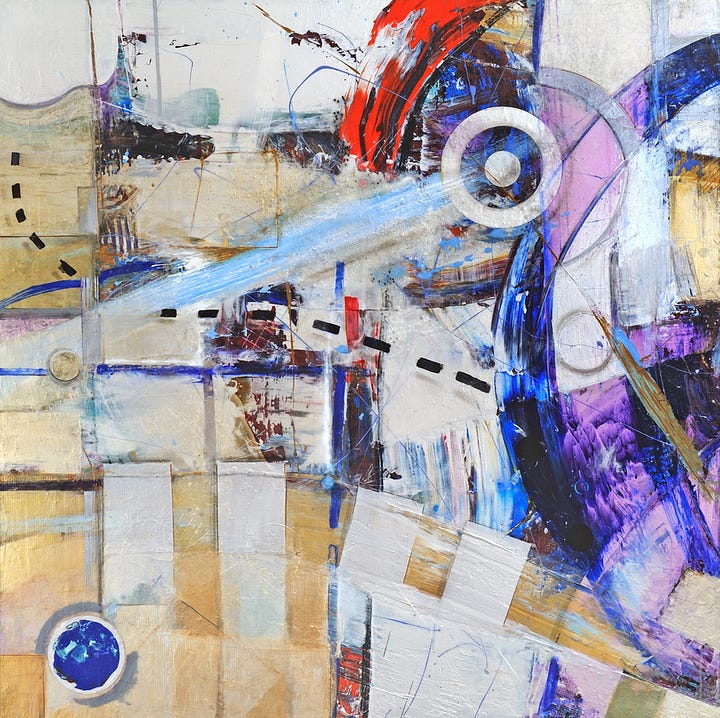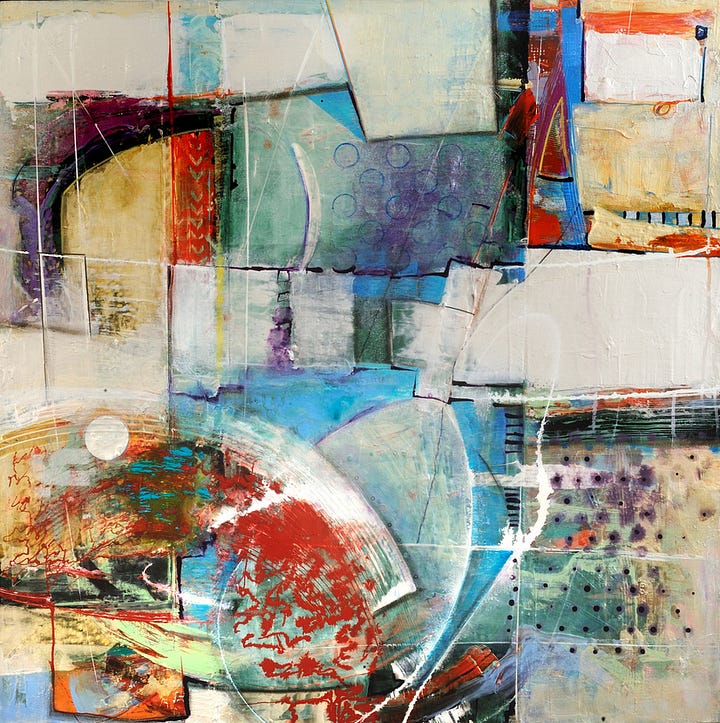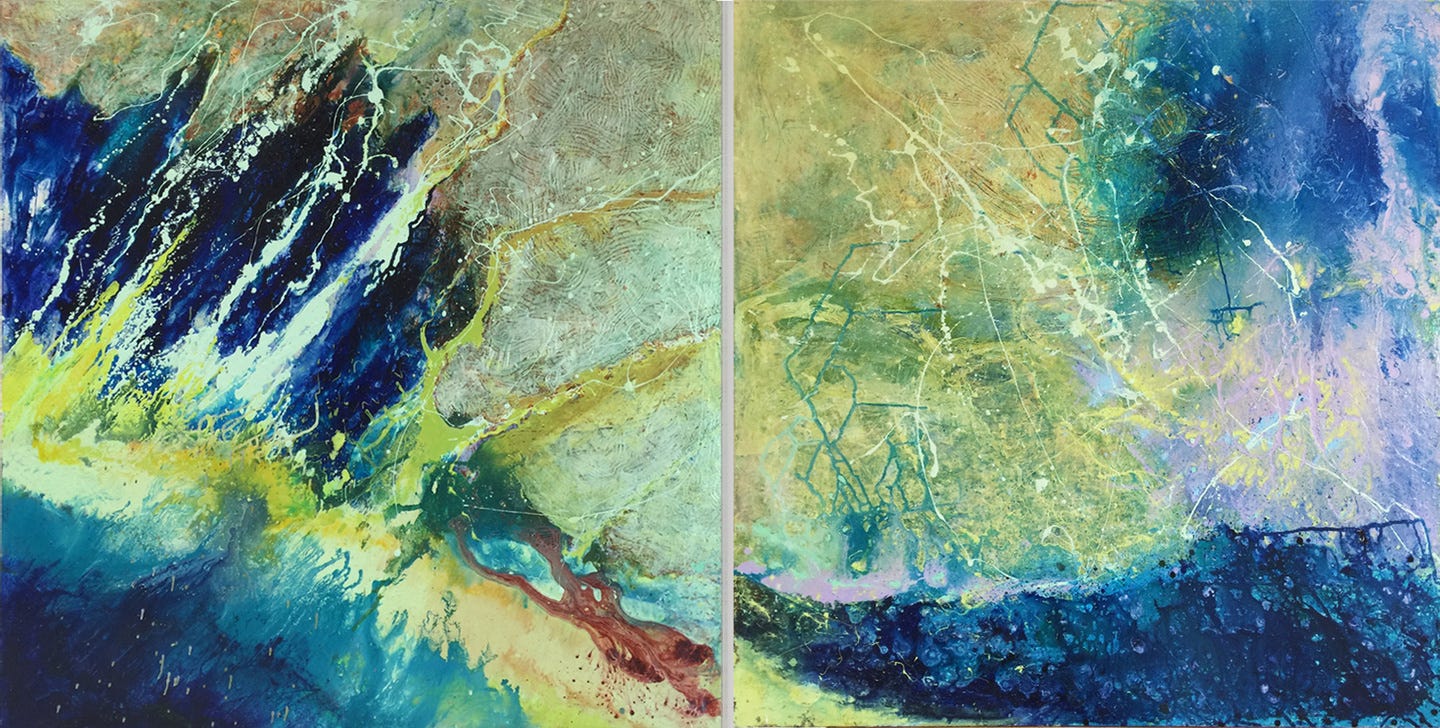Interstellar Affinities
Shape of Space: Abstractions by Anne Marchand September 3 to December 6, 2024 at The Phillips Museum of Art, Lancaster, PA
The notion of landscape as a portrait of the known or the idyllic comes under immediate scrutiny in the paintings of Anne Marchand, whose works are painterly abstraction modeled after views documented originally by the Hubble Telescope, which peers deeply into the recesses and murky infinities of outer space. The works are additionally embroidered with materials such as tree bark, glass beads, sand, and silks, which marries them to nature and culture alternately as surface and context.
Marchand’s current solo exhibition, Shape of Space: Abstractions, on view through early December at The Phillips Museum of Art, presents seventeen recent canvases. If scale is any indicator, we are clearly meant to be looking into infinite distances, and that the depth and expressiveness of Marchand’s individual works invites us to be immersed. There’s a richness and diversity to her works. She uses the source material but does not rely completely upon it, but rather takes it as a jumping off point into expressive arenas in which her complete discipline takes hold. Marchand had a strong penchant for color and gesture, and she’s not afraid of a little chaos. It plays through her works, reshaping perception.

Among them, several stand out. The themes or motifs most aptly and actively featured include the idea of a journey, of travel through immense distances, as if mapping a pilgrimage; she also addresses the concept of imposed presences, celestial personas that embody the unimaginable forces at play in her views of the cosmos; she also addresses the source of everything, looking to plumb the macroverse and find oneness; a musicality to the forms that emerge from her perspective, filling the silent void with another aspect of beauty; and how the energy of interstellar reality is perceived from way down here on the surface of the earth. The ineffable is possible to depict but only at the risk of our past world views, with that expression taken quite literally.
The use of language in Marchand’s titles does not often, if at all, “tell it like it is.” She is not interested in meaning specifically as a form of diverting classification. One cannot judge each of her works in exact terms by the titles used, but rather according to an appreciation of the formal qualities dynamically activating one’s aesthetic responses. Marchand’s mastery of the abstract idiom is predicated by her use of counterpoint between overt imagery and structural or environmental effects. In THE INVISIBLE, the title itself implies that what’s overt is less important than what’s either absent or obscured; she is dipping into a notional imperative that dictates how the locus of attention tends to qualify what’s in front of us, or clear, rather than what’s not.
Marchand’s paintings register on the quantum scale–either intimate or epic–depending upon how we receive them. There is a degree of the magnified moment in them, in which the most specific of impressions can contain myriad dimensions. One imagines the instance that inspired the image in a work such as SOFT SOUNDS (2011), in which an immobile object met with an irresistible force, resulting in a dynamic event that resembles the explosion of a star, and the resulting release of energy. Yet, according to what we know, there is no sound in space, so soft sounds are a concept for the minimum of expected echoes resulting in any event. Perhaps Marchand wants us to imagine something inferred by the painting that isn’t physically possible. The hyper-extension of the imagination into existing yet impossible contexts is a worthwhile endeavor for the art spectator.


These works, individually and altogether, imply structural or procedural constants that propagate a heady degree of engagement. For instance, a feeling for the concept of immense space, one that has been proven to exist in interstellar terms, brings with it concepts of how to measure and give dimensional scale to such an experience. In ‘WIDENING CIRCLES’ and A THOUSAND YEARS (both 2015), we have two separate though similar examples of this. Think of them as intuitive maps of intervals of deep space for which we have no other measuring device. The complexity of spatial effects are delineated and proven as essentially dramaturgical in Marchand’s hands. Think of yourself as a meteorite or space craft covering these distances and how gasses and radiation move and exert ambiguous yet sensuous form, and one gets an idea of how successfully she marshalls them into plausible and beautiful expressions.
A third aspect of Marchand’s work is the confrontation forces merging and emerging at all times in all corners of perception. Two works that describe this well are ELEVATION (2015) and THRESHOLD (2016). In the first work, a single horizontal canvas presents three areas that each in their own wax exert a scale and color effect upon the whole experience. Light blue in the background infers sky, a stream of red and yellows in the center infer fire, and a darker, thicker blue, choppy and impastoed, implies water. The suggestion of the work is that some cataclysmic action, a Biblical pillar of fire, separated one primal element from another; dotted lines and scratches in the surface seem to portend our perspective as an an analysis of the event that signifies either epochal change or a singular event blasting into the everyday. The heightening expectation of a threat to the very veil of reality elevates our mindfulness in artful appreciation of it.
THRESHOLD, however, enacts an awareness of an event that is again, quantum in character. Its actual scale is less important than the poignant depiction of a moment in which primordial forces are forever altered. This could be occurring on an immense level, like a tidal wave or the shifting of continental masses, or it could be the captured event of as infinitesimal as the ripple of water when an object falls into it. To the spectator, it’s the consequences of the event that carry meaning, not the recognized scale. Like the old saying goes, one only steps into the same river once. Everything that follows is a myth or a memory.
Anne Marchand holds the keys to the experiences she has witnessed via the Hubble telescope, but they function only as a means to an end. Her ability with color, and her dedication to continuously evoking forms that leave us palpably altered, this is her legacy. Shapes of Space is the experience of beauty newly defined.




